Clingmans Dome in Smoky Mountain National Park is not only renowned for its breathtaking vistas but also for its diverse wildlife. Exploring this majestic peak provides an opportunity to encounter a variety of fascinating creatures. As you ascend Tennessee’s tallest mountain be on the lookout for the park’s emblematic animal, the black bear. These magnificent creatures roam the area and may occasionally be spotted foraging for food or meandering through the woodlands. Beyond bears, the forests of Clingmans Dome are teeming with a rich array of wildlife. The park as a whole is home to over 200 varieties of birds, 67 native fish species, 65 species of mammals, and over 80 types of reptiles and amphibians. So, lace up your hiking boots and grab your water bottle as we trek about the summit of Clingmans Dome to discover five animals that lurk atop Tennessee’s tallest mountain.
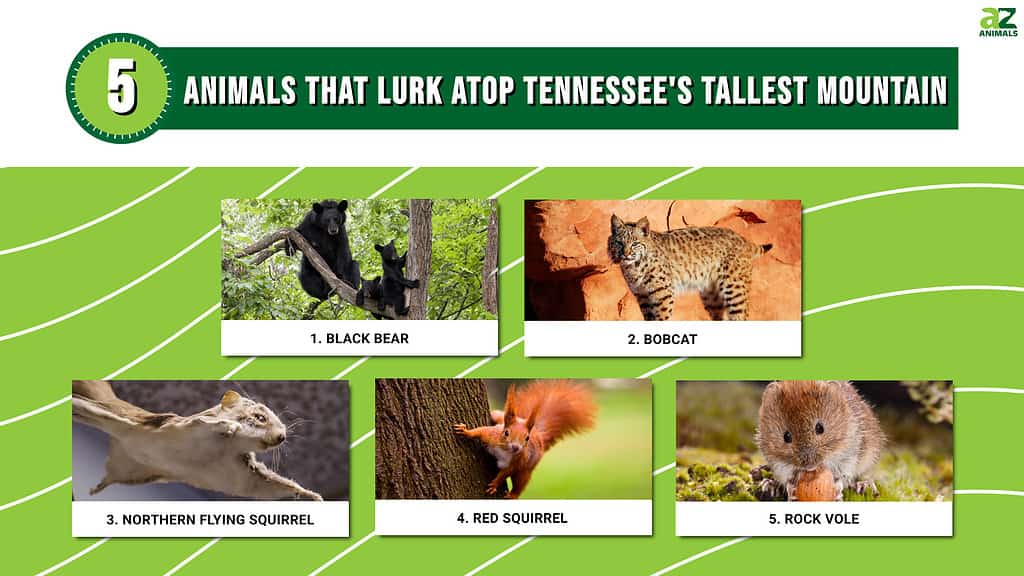
Tennessee’s Tallest Mountain
The highest point in Tennessee is Clingmans Dome, which has an elevation of 6,643 feet (2,025 m) above sea level. It is located in the Great Smoky Mountains National Park, along the Tennessee-North Carolina border. Clingmans Dome offers stunning panoramic views of the surrounding mountains and is a popular destination for hikers and nature lovers.
Clingmans Dome is named after Thomas Lanier Clingman (1812-1897), a prominent American explorer, politician, and scientist. Clingman was a United States Congressman from North Carolina and also served as a Confederate general during the American Civil War. He was known for his exploration of the Southern Appalachians and his contributions to the understanding of the region’s geography and natural history. As a tribute to his achievements, the peak was named Clingmans Dome in his honor. Now, discover five animals that lurk atop Tennessee’s tallest mountain.
1. Black Bear
North American black bears (Ursus americanus) are adaptable animals and can be found in a variety of environments, including the summit of Clingmans Dome. Black bears are medium to large bears. Adult black bears typically have a shoulder height of 2 to 3 feet (0.61 to 0.91 m) and a length from nose to tail of 4-7 feet (1.2-2.1 m). Their weight can vary significantly depending on factors such as age, and available food sources. On average, adult black bears weigh between 100-600 pounds (45-272 kg).
Black bears are known to use different types of dens for various purposes, including hibernation, birthing, and shelter during extreme weather conditions. They are not particular and will choose natural or man-made shelters for denning.
During hibernation, black bears may seek out sheltered areas such as hollow trees, rock crevices, or dense vegetation. They can also utilize caves, but it is more common for them to use natural cavities or construct shallow excavations. In some cases, they may even den in human-made structures like abandoned buildings or culverts.
Outside of the hibernation period, black bears generally do not spend a significant amount of time in dens. They are mostly active during the warmer months and roam over a large home range, searching for food sources such as berries, nuts, insects, and occasionally small mammals or fish.
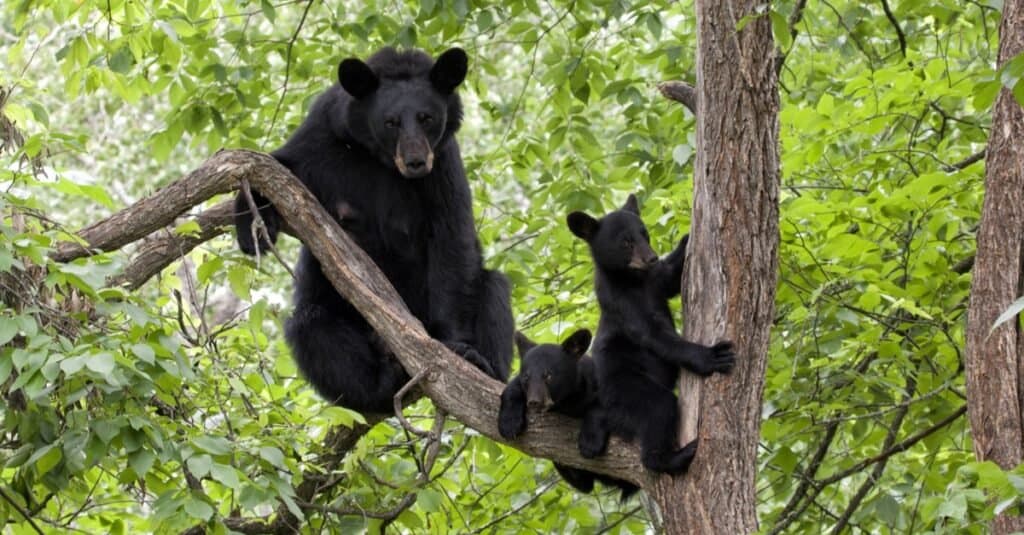
Black bears are capable climbers!
©Debbie Steinhausser/Shutterstock.com
Behavior
North American black bears are primarily crepuscular or diurnal, meaning they are most active during twilight periods (dawn and dusk) and daylight hours. However, their activity patterns can vary depending on several factors, including food availability, human presence, and environmental conditions.
While black bears are not strictly nocturnal, they may exhibit more nocturnal behavior in areas with higher human activity or in regions where they are heavily hunted. In such cases, they may become more active during the night to avoid human encounters and disturbances. This behavior is known as a nocturnal shift and can vary between individuals and populations.
Black bears also adjust their activity patterns based on seasonal changes. During the hot summer months, they will be more active during cooler parts of the day or night. In contrast, during the fall, they may become more diurnal as they actively forage and prepare for hibernation.
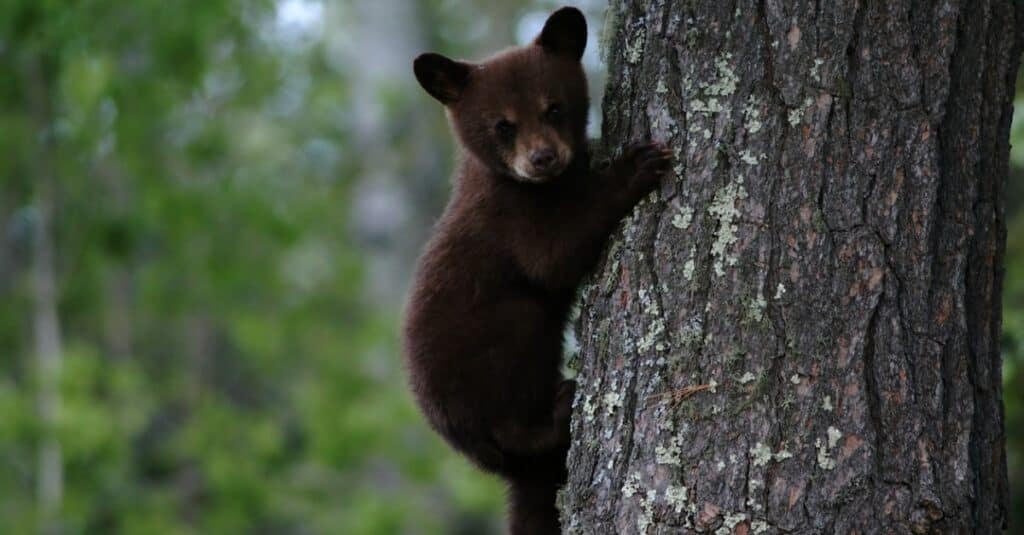
North American black bears (
Ursus americanus) are adaptable animals that can be found in a variety of environments, including the summit of Clingmans Dome.
©iStock.com/EEI_Tony
2. Bobcat
Bobcats (Lynx rufus) are small to medium-sized wild cats native to North America including Clingmans Dome. Bobcats are about twice the size of domestic cats, with compact, muscular bodies. They have short, dense fur that is generally tawny or brownish in color with spots and stripes that act as camouflage.
Their tufted ears have black tips, and they have a short tail that is usually white on the underside with black bars or rings towards the tip. They are adaptable animals and can survive in a range of environments as long as there is sufficient cover and prey availability.
Behavior
Bobcats are solitary and elusive animals. They are primarily nocturnal but may also be active during dawn and dusk. Bobcats are skilled hunters. Their diet consists mainly of small mammals such as rabbits, hares, squirrels, and mice. They are also opportunistic predators and may consume birds, reptiles, and even occasionally larger prey like deer.
Bobcats breed in late winter or early spring. Males will compete for females, and after mating, the female will give birth to a litter of two to four kittens. The kittens are born blind and helpless. They rely on their mother for food and protection. After a few months, the kittens will start learning hunting skills. They become independent at 8-11 months of age.
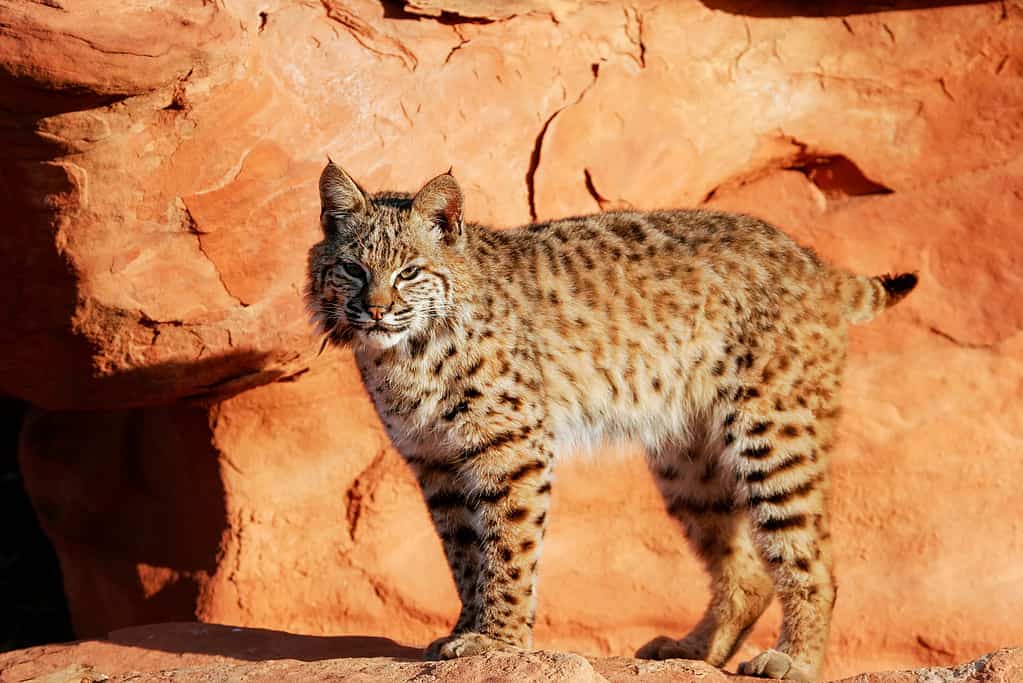
Bobcats (
Lynx rufus) are solitary and elusive animals.
©Don Mammoser/Shutterstock.com
3. Northern Flying Squirrel
Northern Flying Squirrels are one of the animals that lurk atop Tennessee’s tallest mountain. Though the Northern Flying Squirrel (Glaucomys sabrinus) is not usually found as far south as Tennessee, the altitude at Clingmans Dome makes for a suitable Southern habitat. The Northern Flying Squirrel is a small mammal known for its remarkable gliding ability. Northern Flying Squirrels have a similar appearance to other squirrels but with specific adaptations for gliding. They have soft, dense fur that is grayish-brown on their back and pale gray on their belly.
They have large, round eyes and a flattened tail that aids in maneuvering during flight. Their most distinctive feature is the patagium, a fold of skin that extends between their front and hind limbs, allowing them to glide through the air.
Northern Flying Squirrels are found in the northern regions of North America, including parts of Canada and the United States. They inhabit a variety of forested habitats, including coniferous and mixed forests. They prefer mature forests with dense canopies, as they rely on trees for shelter, nesting sites, and food sources.
Behavior
Northern Flying Squirrels are excellent gliders. They have a flap of skin called the patagium that stretches from their wrists to their ankles. By extending their limbs and stretching the patagium, they can glide for impressive distances between trees. Glides of over 100 feet (30 m) have been recorded.
They are primarily nocturnal, using their gliding ability to move efficiently through the forest canopy at night. Their diet consists of a variety of foods, including seeds, nuts, fruits, fungi, insects, bird eggs, and even tree sap.
Northern Flying Squirrels are generally social animals, forming small groups or colonies. They will share nests during the winter for warmth and protection. These nests, called dreys, are constructed in tree cavities, abandoned bird nests, or leafy clumps where they weave together twigs and leaves to create a cozy shelter.
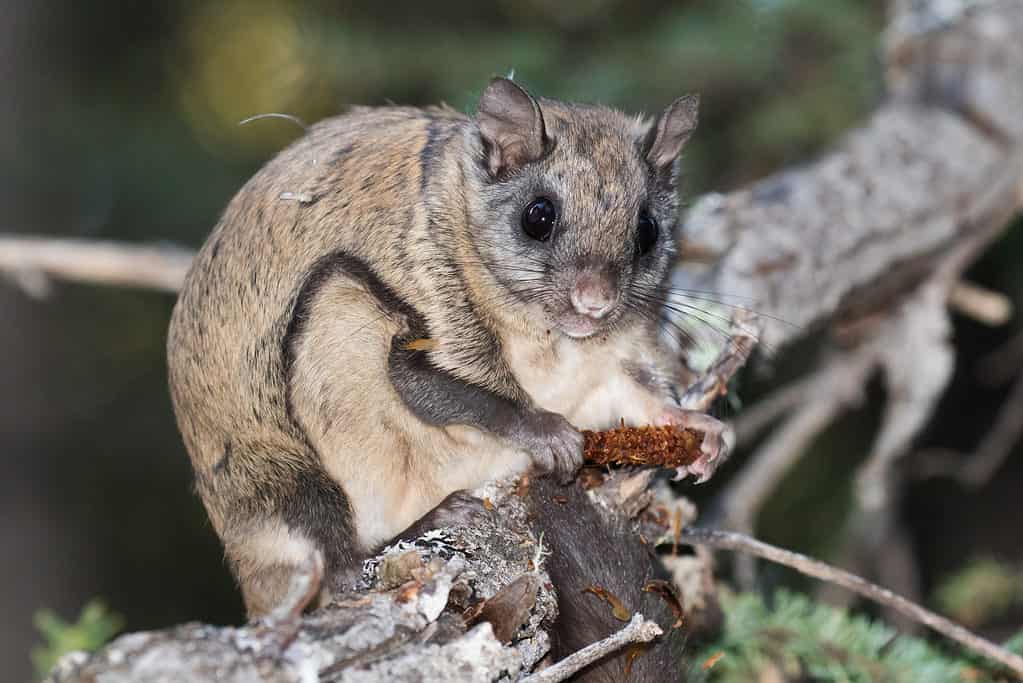
The Northern Flying Squirrel is a small mammal known for its remarkable gliding ability.
©Jukka Jantunen/Shutterstock.com
Reproduction
Northern Flying Squirrels breed in late winter or early spring. Females give birth to litters of 2 to 7 young after a gestation period of about 40 days. The newborns are blind, hairless, and completely dependent on their mothers. They develop quickly and are weaned at eight weeks. By the time they are three months old, the young squirrels start venturing out of the nest and learning to glide. Northern Flying Squirrels are fascinating creatures, well-adapted to their forested habitats.
4. Red Squirrel
Another one of the animals that lurk atop Tennessee’s tallest mountain is the red squirrel. The red squirrel (Sciurus vulgaris) is known for its reddish-brown fur and bushy tail. Red squirrels have a reddish-brown coat of fur on their upper body, while their underbelly is typically white or cream-colored. Their tail is long and bushy, which they use for balance and communication.
Red squirrels have sharp claws and strong hind legs adapted for climbing and leaping among trees. Red squirrels are diurnal, meaning they are primarily active during the daytime. They are agile climbers and spend much of their time in trees, foraging for food and navigating through the branches.
Their diet consists of a variety of foods, including seeds, nuts, acorns, pine cones, berries, mushrooms, and even tree bark and sap. They are known to hoard food by burying it in the ground for future consumption.

The red squirrel (
Sciurus vulgaris) is known for its reddish-brown fur and bushy tail.
©seawhisper/Shutterstock.com
Reproduction
Red squirrels typically breed once or twice a year, with peak mating seasons occurring in late winter and early summer. Males compete for females through vocalizations and chasing. After mating, the female builds a nest called a drey in a tree cavity or leafy nest. The female gives birth to a litter of typically 2 to 5 young, known as kits, after a gestation period of around 38 to 40 days. The kits are born hairless, blind, and helpless, relying on their mother for nourishment and care.
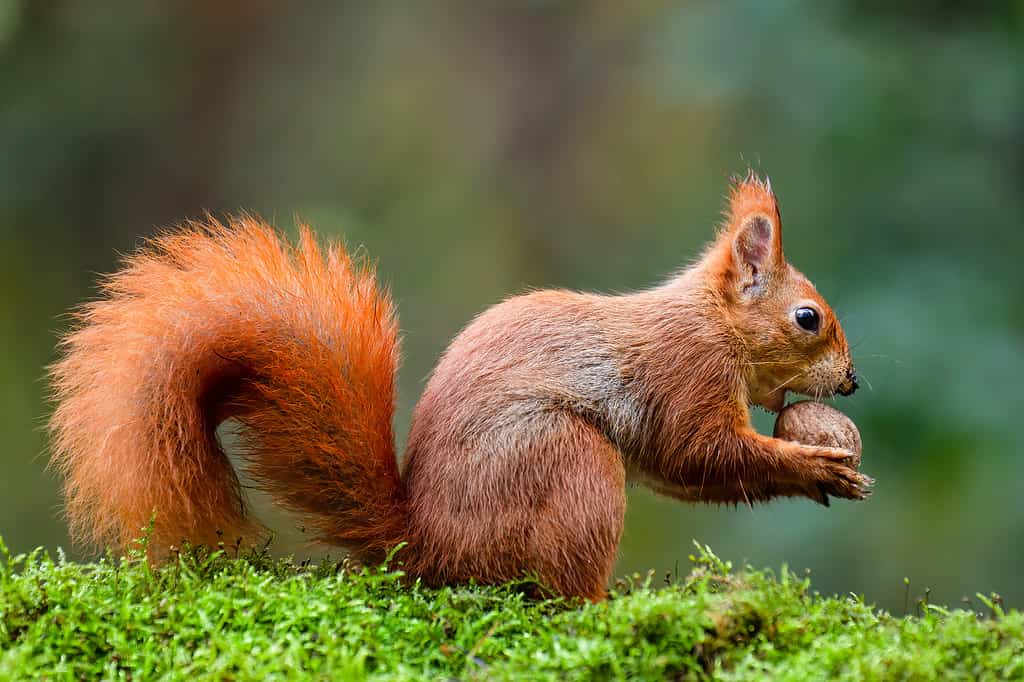
A red squirrel’s diet consists of a variety of foods, including seeds, nuts, acorns, pine cones, berries, mushrooms, and even tree bark and sap.
©Koen Adriaenssen/Shutterstock.com
5. Rock Vole
The rock vole, (Microtus chrotorrhinus) also known as the yellow-nosed vole, is a small mammal belonging to the family Cricetidae. Rock voles have a compact, stocky body with short legs and a short tail. They typically measure around 10 to 15 centimeters in length, excluding the tail. Their fur coloration can vary depending on the region and subspecies, but they generally have brownish-gray fur on their upper body and a lighter gray or white underbelly.
One of their distinguishing features is a yellowish or buff-colored nose, which gives them their alternative name. Rock voles are native to North America, primarily found in rocky habitats such as talus slopes, cliffs, and rocky outcrops. They are most commonly found in the northeastern and northwestern regions of the United States and parts of Canada. Rock voles are well adapted to their rocky environments, using crevices and rock piles for shelter and protection.
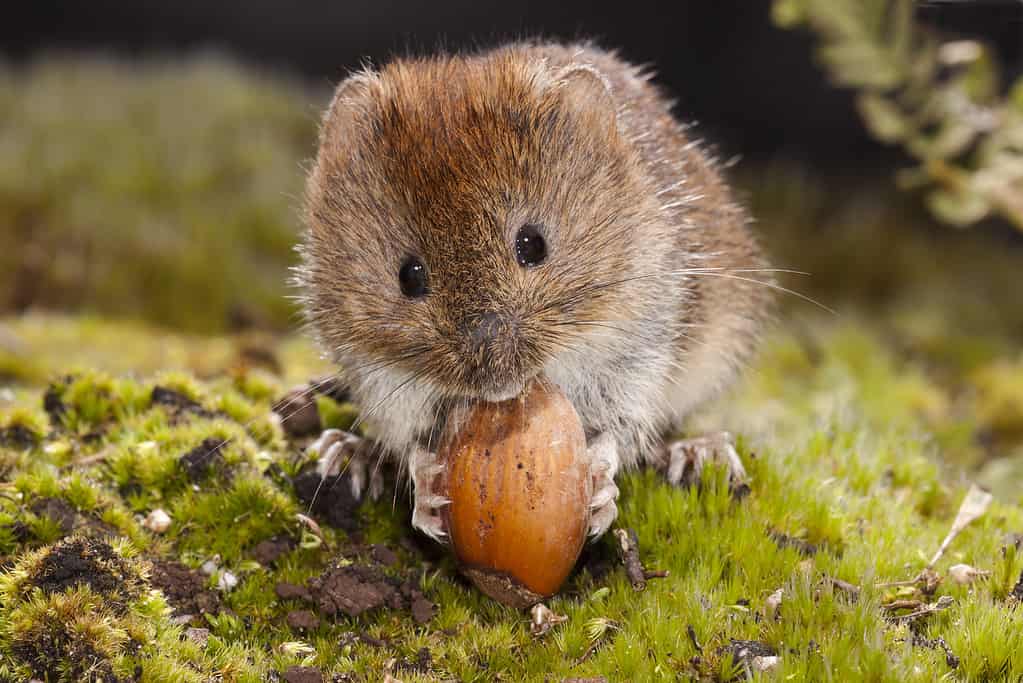
The rock vole’s diet includes nuts, seeds, grasses, and mosses.
©iStock.com/AGAMI stock
Diet and Behavior
Rock voles are herbivorous, feeding on a variety of vegetation. Their diet includes nuts, seeds, grasses, and mosses They are active throughout the year, though their activity patterns can vary depending on environmental conditions. Rock voles are not strong climbers but are well adapted to navigating rocky terrain.
There is very little information available regarding the social behavior of rock voles. However, they have been observed living in colonies or small groups. Within their colonies, they create an extensive network of tunnels in the ground. These tunnels provide protection from predators.
Rock voles breed during the spring and summer months. Females have a gestation period of approximately three weeks, after which they give birth to a litter of typically three to six young, although litter size can vary. The newborns are blind, hairless, and dependent on their mothers for nourishment. They develop rapidly and are weaned at around three weeks of age. Rock voles can reproduce multiple times within a breeding season.
Summary of 5 Animals That Lurk Atop Tennessee’s Tallest Mountain
| # | Animal | Fun Fact |
|---|---|---|
| 1 | Black Bears | Other than during hibernation, black bears spend most of their time outside of dens |
| 2 | Bobcats | They are highly adaptable and can survive almost anywhere |
| 3 | Flying Squirrels | Highly social animals – they live in little groups or colonies in shared nests |
| 4 | Red Squirrels | They hoard food and hide it away for later |
| 5 | Rock Voles | Their large colonies live in elaborate tunnels underground |
The photo featured at the top of this post is © Menno Schaefer/Shutterstock.com
Thank you for reading! Have some feedback for us? Contact the AZ Animals editorial team.






